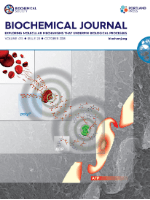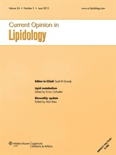
CHEMISTRY AND PHYSICS OF LIPIDS
Scope & Guideline
Connecting biochemistry and molecular biology through lipids.
Introduction
Aims and Scopes
- Lipid Biochemistry and Metabolism:
Research in this area delves into the synthesis, degradation, and metabolic functions of lipids, including their roles in cellular signaling and energy storage. - Biophysical Characterization of Lipid Systems:
Studies involving advanced techniques such as molecular dynamics simulations, atomic force microscopy, and NMR spectroscopy to explore lipid structures and interactions at the molecular level. - Lipid-Drug Interactions and Delivery Systems:
This scope includes investigations into how lipids can enhance the solubility and bioavailability of pharmaceuticals, with a focus on liposomal and nanoparticle formulations. - Lipid Dynamics in Biological Membranes:
Research examining how lipids contribute to membrane fluidity, stability, and the formation of lipid rafts, as well as their interactions with proteins and other biomolecules. - Therapeutic Applications of Lipids:
Exploration of lipid-based therapies in various diseases, including cancer, cardiovascular diseases, and neurodegenerative disorders, highlighting their potential as drug delivery systems.
Trending and Emerging
- Lipid Nanocarriers for Drug Delivery:
There is an increasing focus on designing lipid-based nanocarriers that improve drug delivery efficiency, particularly for cancer therapies and targeted treatments. - Lipidomics and Biomarker Discovery:
Research in lipidomics is on the rise, particularly in identifying lipid biomarkers for diseases such as cancer and metabolic disorders, which can aid in early diagnosis and personalized medicine. - Integrative Studies of Lipids and Proteins:
Emerging studies that focus on the interactions between lipids and membrane proteins are gaining traction, emphasizing the importance of lipid-protein dynamics in cellular functions. - Lipid-Based Therapies for Neurodegenerative Diseases:
A notable increase in research dedicated to the role of lipids in neurodegenerative diseases, exploring how lipid metabolism and composition can influence disease progression and therapy. - Sustainable Lipid Sources and Biodegradable Lipids:
Growing interest in using sustainable and biodegradable lipid sources for various applications, including food science and pharmaceuticals, reflects a broader trend towards eco-friendly research.
Declining or Waning
- Traditional Lipid Extraction and Analysis Techniques:
There has been a noticeable reduction in papers focused on conventional lipid extraction methods, as newer, more efficient techniques are being adopted. - Basic Lipid Composition Studies:
Research solely dedicated to the characterization of lipid compositions without exploring functional implications or interactions has decreased, indicating a shift towards more integrative studies. - Static Lipid Models:
The use of static models for studying lipid behavior and interactions is declining, with a growing preference for dynamic and in vivo models that better replicate biological conditions.
Similar Journals

Nature Metabolism
Unlocking the mysteries of metabolism and health.Nature Metabolism, published by NATURE PORTFOLIO, is a leading journal dedicated to advancing the field of metabolic research and its implications across various biological systems. Since its inception in 2019, this esteemed journal has rapidly established itself as a vital resource for researchers, professionals, and students alike, reflecting its prominence through a prestigious Q1 ranking in several key categories including Cell Biology, Endocrinology, Diabetes and Metabolism, Internal Medicine, and Physiology. With an impressive Scopus ranking, underscoring its impact in Medicine and Biochemistry disciplines, Nature Metabolism offers an exceptional platform for disseminating high-quality research that explores the intricate mechanisms of metabolism and its association with health and disease. Although currently not open access, it continues to gain visibility and appreciation within the scientific community, ensuring that groundbreaking findings reach interested audiences globally from its hub in Berlin, Germany. Whether you are an experienced researcher or an aspiring student, Nature Metabolism serves as an invaluable asset in navigating the complexities of metabolic science.

BIOCHEMICAL JOURNAL
Advancing the Frontiers of Biochemical ResearchBIOCHEMICAL JOURNAL, published by Portland Press Ltd, stands as a leading publication in the fields of Biochemistry, Cell Biology, and Molecular Biology, reflecting a commitment to advancing scientific knowledge since its inception in 1945. With a distinguished Q1 ranking across these categories and impressive Scopus rankings, the journal serves as an invaluable resource for researchers, professionals, and students alike, facilitating critical discoveries and innovative research practices. Although not currently offering open access, the journal provides a platform for high-quality peer-reviewed articles, ensuring rigorous standards in the dissemination of biochemical research. Spanning over seven decades and continuing through to 2024, the BIOCHEMICAL JOURNAL fosters an environment where cutting-edge biochemical research thrives, supporting the global scientific community's efforts to address complex biological questions and enhance our understanding of fundamental cellular processes.

BIOPHYSICAL CHEMISTRY
Connecting disciplines to illuminate the science of life.BIOPHYSICAL CHEMISTRY, published by Elsevier, is a prestigious journal with a long-standing tradition since its inception in 1973. This highly respected journal focuses on the intersections of biochemistry, biophysics, and organic chemistry, providing a critical platform for researchers, professionals, and students to disseminate pivotal findings in these dynamic fields. With an impressive impact factor that reflects its robust academic influence and high citation rates, it ranks within the Q2 quartile among its peers in multiple categories, indicating its significance in the scholarly community. The journal, hosted in the Netherlands, encompasses a diverse range of topics, from molecular interactions to protein folding, and serves as an essential resource for those engaged in cutting-edge research. Researchers looking to share their work with a global audience will find BIOPHYSICAL CHEMISTRY an invaluable outlet, fostering the advancement of knowledge in this crucial area of science. For more information, visit the journal's page on the Elsevier platform.

JOURNAL OF BIOLOGICAL PHYSICS
Exploring the Synergy of Life and MatterThe JOURNAL OF BIOLOGICAL PHYSICS, published by Springer, is a premier interdisciplinary journal that focuses on the intersection of biological sciences and physics. With an ISSN of 0092-0606 and an E-ISSN of 1573-0689, this journal serves as a significant platform for researchers and professionals to publish innovative studies, covering fields such as atomic and molecular physics, biophysics, cell biology, and molecular biology. The journal has been a key player since its inception in 1973, showcasing rigorous scientific inquiry and advancing knowledge within these domains, reflected in its categorization in the Q3 and Q4 quartiles of various relevant fields as of 2023. While it currently operates without an Open Access model, the journal continues to provide pivotal contributions to its audience, supporting academic and practical advancements in biological physics while engaging a broad scope of scholarly discourse.

LIPIDS
Innovating understanding of lipids in health and disease.LIPIDS is a renowned peer-reviewed journal published by Wiley, dedicated to the field of lipid research, encompassing biochemistry, molecular biology, and organic chemistry. With its roots dating back to 1966 and a commitment to advancing knowledge until 2024, this journal serves as a vital platform for sharing significant findings in lipid biochemistry and its applications in health and disease. Although it currently does not offer Open Access options, it maintains a respectable standing with a Q3 ranking in Biochemistry and Organic Chemistry, and a Q4 ranking in Cell Biology based on the 2023 category quartiles. Additionally, its Scopus rankings reflect a solid position within the organic chemistry and biochemistry subfields. Published from Germany, LIPIDS caters to researchers, professionals, and students eager to explore the roles of lipids in biological processes and innovatory applications in various scientific disciplines.

Annual Review of Biophysics
Driving Innovation Through Comprehensive ReviewsThe Annual Review of Biophysics, published by ANNUAL REVIEWS, stands as a premier journal in the field of biophysics, offering an unparalleled collection of comprehensive and insightful reviews that synthesize the latest advancements in biochemistry, bioengineering, cell biology, structural biology, and more. With an impressive Q1 ranking across multiple categories as of 2023, this journal is recognized for its significant contribution to the scientific community, highlighted by its robust Scopus ranking—placing it in the 99th percentile for biophysics and the 96th percentile for structural biology. Operating under an open access policy, the journal ensures a broad dissemination of crucial findings and theoretical advancements. As the field of biophysics continues to expand, the Annual Review of Biophysics remains essential for researchers, professionals, and students seeking to stay informed about pivotal developments that shape our understanding of biological systems at the molecular level. One may refer to the journal for current trends, innovative methodologies, and a wealth of knowledge that drives the field forward.

BIOLOGICHESKIE MEMBRANY
Illuminating the Pathways of Biological DiscoveryBIOLOGICHESKIE MEMBRANY is a critical journal in the field of Cell Biology and Molecular Biology, published by MEZHDUNARODNAYA KNIGA in the Russian Federation. With an ISSN of 0233-4755, this journal has been serving the academic community since 1996 and continues to publish cutting-edge research that advances our understanding of biological membranes and their functions. Despite being classified in Q4 quartiles for both Cell and Molecular Biology in the 2023 category rankings, the journal presents a unique platform for emerging research within these pivotal areas. Researchers, professionals, and students alike will find valuable insights in its pages as it seeks to foster a collaborative environment that encourages knowledge sharing. Although currently not available as an open-access journal, it remains an essential resource for those looking to deepen their knowledge and contribute to ongoing discussions in the biological sciences. The journal’s commitment to publishing quality research is underscored by its continuous coverage until 2024, making it a sustained reference in the field.

CURRENT OPINION IN LIPIDOLOGY
Exploring the forefront of lipid science.Current Opinion in Lipidology is a premier journal published by Lippincott Williams & Wilkins, offering critical insights into the ever-evolving landscape of lipid research. With an impressive convergence spanning from 1990 to 2024, this journal serves as an essential platform for researchers, clinicians, and professionals dedicated to the study of lipids in relation to cardiovascular health, endocrinology, and metabolism. The journal currently holds a distinguished Q1 ranking in Cardiology and Cardiovascular Medicine, Endocrinology, Diabetes and Metabolism, and Nutrition and Dietetics, showcasing its significant impact in these fields. Additionally, it ranks in the Q2 quartile for Cell Biology and Molecular Biology, underlining its comprehensive approach to lipidology. Though not open access, the content is rich with cutting-edge reviews, clinical studies, and expert opinions that aim to advance knowledge and practice in lipid metabolism, making it a valuable resource for anyone seeking to stay abreast of the latest developments in lipid research.

Biophysical Reports
Connecting Theory with Practice in Biophysical ResearchBiophysical Reports is an esteemed peer-reviewed journal published by Elsevier, dedicated to advancing the field of biophysics and related disciplines. Since its inception in 2021, this journal has rapidly gained recognition, achieving a Q1 ranking in Biophysics and Q2 rankings in both Biochemistry categories and Biotechnology as of 2023. The journal serves as a pivotal platform for disseminating innovative research findings and theoretical advancements, catering to a diverse readership that includes researchers, professionals, and students in the life sciences. With an ISSN of 2667-0747, Biophysical Reports aims to bridge the gap between molecular biochemistry and physical sciences, providing critical insights that contribute to the understanding of biomolecular processes. While offering no open-access options, it adheres to rigorous publication standards, ensuring high-quality content that reflects contemporary challenges and breakthroughs in biophysical research. For those engaged in the biosciences, this journal stands as an invaluable resource for exploring the intricacies of molecular interactions and the implications for biotechnology and genetic studies.

AAPS PHARMSCITECH
Transforming Challenges into Breakthroughs in Drug DevelopmentAAPS PHARMSCITECH is a prestigious peer-reviewed journal published by Springer, focusing on the dynamic field of pharmaceutical sciences and technology. With an ISSN of 1530-9932, it provides a vital platform for disseminating cutting-edge research that spans key areas including drug discovery, pharmacology, toxicology, and ecological impacts of pharmaceuticals. The journal is recognized for its rigorous scientific contributions, currently holding a commendable Q2 quartile ranking across several relevant categories, including Agronomy and Crop Science, Aquatic Science, and Medicine in 2023. Notably, it ranks 43rd out of 183 in the Scopus Pharmacology, Toxicology, and Pharmaceutics category, placing it in the 76th percentile of its field. Aiming to foster innovation and collaboration among researchers, professionals, and students, AAPS PHARMSCITECH is committed to advancing scientific knowledge and addressing contemporary challenges in pharmaceutical sciences. The journal offers various access options to ensure wide dissemination of research findings, making it an essential resource for those dedicated to enhancing public health through pharmaceutical advancements.